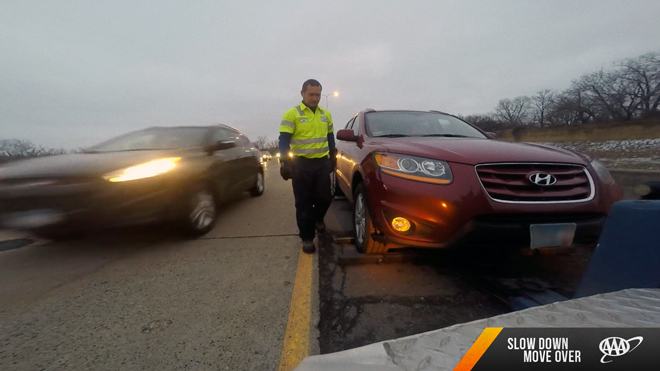
BOISE – As the daylight hours get shorter, AAA is asking drivers to help emergency workers at the roadside stay safe. Nationwide, an average of two tow operators and first responders are killed each month while at the scene of a crash, disabled vehicle, or other roadway incident.
According to research by the Centers for Disease Control and Prevention, the towing industry is 15 times deadlier than all other private industries combined, with an annual fatality rate of 43 deaths per 100,000 workers. For other private industries, the rate is 2.8 deaths per 100,000 workers.
All states have enacted “Move Over” laws requiring drivers to slow down when they approach a stationary emergency vehicle with flashing lights and, if possible, move over one lane to provide workers with enough space to safely do their job. But new research by the AAA Foundation for Traffic Safety finds that nearly 23% of Americans do not know that such laws exist, and nearly 30% of those who do know about the law don’t completely understand it.
“Idaho’s Move Over law specifically protects police vehicles, emergency vehicles, tow trucks, and highway incident response vehicles,” says AAA Idaho public affairs director Matthew Conde. “For many first responders and emergency workers, the roadside is their office. They’re putting their lives at risk to improve safety for everyone. Drivers can return the favor by being extra careful.”
In AAA’s research, many Americans report doing the right thing when they approach an emergency vehicle, with nearly 93% saying they slow down and/or change lanes every time they can. However, drivers ages 16 to 18 are significantly less likely to take appropriate action (85%).
Drivers who do not always observe the Move Over law offered several reasons for their behavior, such as lack of space to change lanes, concerns that reducing speed might cause a crash (either by hitting the vehicle in front of them or being struck from behind), or a lack of time to react.
“It may not always be possible to move over, but the first point of emphasis is to slow down,” Conde said. “If you’re concerned about not having enough time to react, please increase your following distance to keep a little more space between yourself and the car in front of you.”
Interestingly, of the drivers who slowed down and moved over whenever possible, 86% perceived violations of the Move Over law to be very dangerous. For those who didn’t comply every time, 42% felt that a violation of the law was somewhat or not at all dangerous.
“It’s clear that we need to raise awareness and address some big knowledge gaps surrounding this issue,” Conde said. “Our first responders and emergency workers deserve to make it home safe.”
To protect roadside workers and improve highway safety, AAA offers these precautionary tips:
- Always remain alert. Avoid distractions and focus on the task of driving.
- Maintain a visual lead of everything going on 20 to 30 seconds ahead of you. This gives you time to see problems ahead and change lanes and adjust speed accordingly.
- Emergencies can occur anywhere on the road. When you see flashing lights, slow down and prepare well in advance to change lanes. Allow others to merge into your lane when necessary.
- Don’t follow semi-trucks or other large vehicles too closely. If a truck moves into a left-hand lane, don’t speed around the right side. They are changing lanes for a reason; be prepared to change lanes yourself.
- When road conditions are slick, don’t make sudden lane changes which can cause an uncontrollable skid. Change lanes early and move over gradually.
- If you are unable to move over, slow down to a safe speed, taking into consideration that you are approaching a workspace where pedestrians are present.

